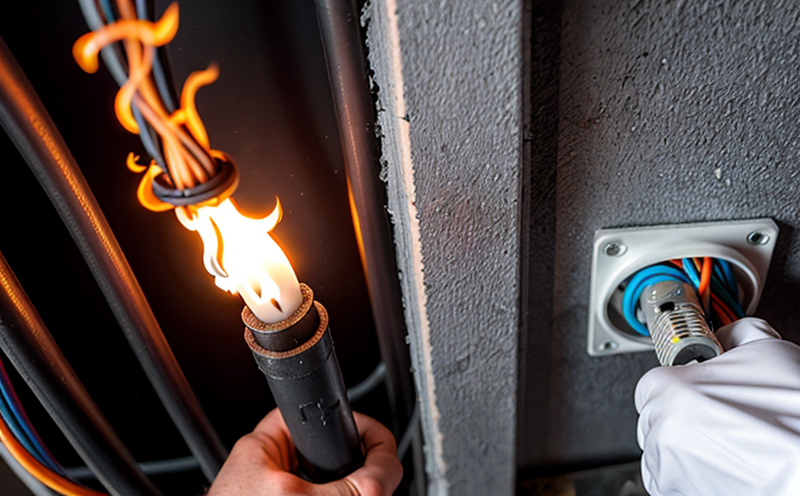Heat Release Rate Testing of Cable Assemblies
In today’s rapidly evolving world, fire safety is more critical than ever. Cables and wiring form a significant part of any electrical system, and their behavior during a fire can have severe implications for human life and property. Heat release rate (HRR) testing is an essential tool in the evaluation of cable assemblies’ combustibility characteristics under controlled conditions.
This testing method measures the amount of heat released per unit area by a sample as it burns. The HRR test provides critical data that helps ensure compliance with fire safety regulations and improves product design for enhanced fire resistance. This service is vital for quality managers, compliance officers, R&D engineers, and procurement specialists who need to guarantee the performance and reliability of their products under extreme conditions.
The testing process involves subjecting a cable assembly sample to controlled combustion in a calorimeter. The calorimeter measures the heat released by the burning sample over time. This data is then used to calculate the HRR value, which indicates the intensity of heat release during fire exposure. Higher HRR values suggest that more heat is being generated, posing greater risk in a real fire scenario.
The test setup typically includes a calorimeter chamber where the cable assembly is placed and ignited using a specific method. The temperature and combustion rate are monitored to capture accurate data on heat release. This process helps identify which areas of the cable may be prone to higher HRR, allowing manufacturers to make necessary improvements in design or material selection.
Accurate testing ensures that products meet stringent fire safety standards set by regulatory bodies worldwide. For instance, in the United States, UL and NFPA have specific requirements for the heat release characteristics of various materials used in electrical systems. Similarly, international standards like ISO and EN specify acceptable limits for HRR based on material types and intended application.
Understanding the results from HRR testing is crucial not only for compliance but also for product development. By analyzing these test results, manufacturers can optimize their designs to reduce heat release, thereby enhancing fire safety performance. This service plays a pivotal role in ensuring that cable assemblies meet the necessary criteria to protect end-users and adhere to global fire safety standards.
Heat release rate testing is particularly important in sectors like aerospace, automotive, electronics manufacturing, and construction. In these industries, electrical systems are integral to operations, making it imperative to ensure their reliability under all conditions. By incorporating this service into the product development process, companies can enhance overall system performance while maintaining a high standard of fire safety.
For quality managers and compliance officers, HRR testing offers valuable insights into product performance during combustion events. R&D engineers benefit from the data collected to refine their designs and improve material choices. Procurement teams use these results to select suppliers who meet stringent fire safety requirements.
Applied Standards
| Standard | Description |
|---|---|
| UL 746E | This standard specifies the procedures for determining the heat release rate of electrical insulation materials used in wiring and cable assemblies. |
| ISO 56601-2:2018 | This international standard provides methods for measuring smoke production, carbon monoxide generation, and heat release rate during flaming combustion of plastics. |
| EN 455-2:2013 | This European standard outlines the procedures for determining the heat release rate from materials used in electrical installations. |
| ASTM E662-18 | American Society for Testing and Materials (ASTM) standard that specifies the procedure for measuring heat release rate of plastic materials using oxygen consumption calorimetry. |
The application of these standards ensures consistent testing protocols across different geographical regions, thereby facilitating global market access. Compliance with these standards is essential for manufacturers to ensure their products meet regulatory requirements and perform reliably under fire exposure conditions.
Environmental and Sustainability Contributions
Heat release rate testing contributes significantly to environmental sustainability by helping reduce the risk of fires in various applications, which can prevent significant damage to both property and lives. By ensuring that cable assemblies meet stringent fire safety standards, this service helps mitigate the potential for catastrophic incidents.
In addition to enhancing public safety, this service also supports sustainable product design practices. By identifying areas where HRR can be reduced, manufacturers can optimize their designs without compromising functionality or performance. This approach not only enhances fire safety but also reduces material usage and waste, contributing positively to environmental sustainability.
For instance, in the automotive industry, reducing heat release from wiring harnesses can lead to lighter vehicles, which improve fuel efficiency and reduce carbon emissions. In commercial buildings, ensuring that electrical systems meet HRR standards helps prevent fires, thereby protecting valuable infrastructure while minimizing the need for costly repairs or replacements.
The use of advanced materials in cable assemblies developed through this service can also contribute to a circular economy by promoting the reuse and recycling of materials. By selecting fire-resistant materials with lower HRR values, manufacturers can facilitate easier disposal and recycling processes, reducing landfill waste.
Competitive Advantage and Market Impact
- Innovation in Product Development: By incorporating heat release rate testing into their product development process, companies gain a competitive edge. This service allows them to innovate faster and bring safer products to market.
- Enhanced Reputation: Compliance with international fire safety standards enhances a company’s reputation as a leader in quality and reliability.
- Better Risk Management: Understanding HRR values helps companies manage risks associated with electrical fires, leading to more robust product designs.
- Market Access: Meeting specific regulatory requirements opens doors for global market access, enabling brands to compete on a broader scale.
The ability to demonstrate compliance with these standards through rigorous testing can significantly influence purchasing decisions made by buyers and consumers. This service not only ensures product safety but also builds trust among stakeholders, contributing to long-term business success.





